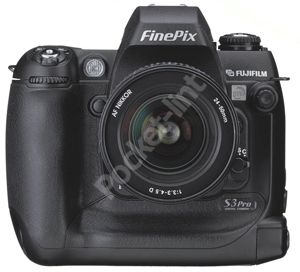The S3 Pro is, as you might expect a camera replete with professional specification features including up 1/4000sec shutter speed, Nikon F lens mount compatibility and both hot shoe and separate flash synch terminal for studio flash. You get 4 AA-battery power housed within a special slide that fits neatly into the vertical grip. The latter has its own shutter button and the nicely sculpted body while bulkier overall, as a result is very nice to handle.
Our quick take
I've been in the fortunate position to have reviewed the S1 Pro, then this Digital-SLR's (D-SLR) predecessor, the S2 Pro (twice in fact, as I compared it to its peers (which it beat) a year later) and I then wrote the First Look article on the new, S3 Pro D-SLR for Professional Photographer: I'm familiar with it's evolution therefore.
Although the S3 Pro looks overpriced compared to many of the D-SLRs appearing on the market, it must be remembered this is not a sports photographer's snapper. It offers uniqueness with its wide dynamic range, thanks to the dual pixel layout that makes it a real social photographer's tool where skin tones and whites (of wedding dresses) are the key to a good shot. A corker then, but one for a niche within niche of the photo market.

Fuji FinePix S3 Pro - 4.0 / 5
| FOR | AGAINST |
|---|---|
|
|
Key among the new models spec is the SuperCCD SR II sensor, a chip that houses two types of photo diode to capture light. The S-pixels record ‘normal' light values while the R-pixels capture high frequencies of light (brighter/whiter) subjects offering an image capture quality analogous to colour film. The sensor is actually designed with the silver halide grain structure in film as its basis.
Explaining further The new SuperCCD SR II sensor is the same size and has the same octagonal shape as its predecessor, it has both the ‘S' and the ‘R' photo diode locations, but split onto separate but adjacent pixels (making the camera a ‘true' 6MP + 6MP model says Fuji). Splitting them onto discreet pixel locations means improvements in signal to noise ratio and provides a total of 6.49MP x 6.49MP (12.9MP) resolution with 12.1MP effective pixels. You can select between the two sets of pixels using either the ‘S' pixels on their own or combining them with the ‘R' pixels when that greater dynamic range is required.
The camera has better processing algorithms over its S2 sibling and associated image handling systems combined with the new sensor for improved dynamic range, improved tonal capabilities and better colour balance, combined with the less image noise and improved picture quality.
The CCD-RAW mode offers the best use of the dual pixel configuration since the in camera processing in other modes mysteriously processes away some of this vital information, which seems very strange indeed given the cameras main boasting point.
However, that foible aside the camera provides a superb level of sophistication with the Nikon Lens compatibility being another key factor. Sensitivity (ISO equivalence of film) runs from ISO 100, 160 and 200 through ISO 400, 800m and 1600. Noise is well controlled but once above ISO 400 things start to go down hill.
Colour embedding is possible (Adobe RGB) and allows for improved colour gamut making the most of the SR II sensor system and the camera has a superbly fast start up time (under a second) allowing fast reactions to changing environments. However, the drive mode is slow and the AF hunting problem was irksome.
Because you can select to shoot in just the S-pixel mode or the dual ‘S' and ‘R'-pixel together the combination means you'll get faster response or more detail in highlights respectively. USB 2.0 and FireWire (IEEE1394) connectivity means speedy upload of images to PC. Image quality is as good as I had hoped (bar the odd, over processing problems in JPEG shooting mentioned above) with colour; highlight detail and overall detail all well maintained.
To recap
Fuji’s long awaited S3 Pro is a superb piece of kit, ideal for the social photographer however it’s a bit pricey given the latest kit on the market.
